|
|
|
Sort Order |
|
|
|
Items / Page
|
|
|
|
|
|
|
| Srl | Item |
| 1 |
ID:
169841


|
|
|
|
|
| Summary/Abstract |
Renewable energy development in deregulated electricity markets dominated by fossil fuels has benefited from various government incentives and green marketing. Electricity generation in New Zealand is dominated by renewables and has developed with no government incentives or green marketing since the reforms in 1986. The New Zealand government has set a renewable energy target of 90% by 2025 with no direct support. The objective of this paper is to assess the potential for consumer-driven renewable energy development required to achieve this target by estimating willingness to pay for green electricity in the context of supplier choice. The study is based on a stated choice dataset generated using a choice experiment administered to an online panel of domestic electricity consumers in 2014. Results from a random parameter logit model estimated on 2688 choice responses show that, on average, consumers are willing to pay an extra $3.20 per month or 2% of their current power bills for a 10 percentage point increase in the share of electricity from renewable sources. These findings demonstrate that consumers are willing to support the development of renewables even where a market is dominated by renewables.
|
|
|
|
|
|
|
|
|
|
|
|
|
|
|
|
| 2 |
ID:
162329
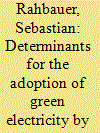

|
|
|
|
|
| Summary/Abstract |
In Germany, the substitution of green electricity (GE) from renewable energy sources for nuclear and fossil electricity is politically intended, yet the demand for GE remains limited. This article provides empirical insight into factors influencing the decision of German small- and medium-sized enterprises (SMEs) to adopt GE. Potentially relevant factors are identified through a review of the previous literature and investigated using logit model analyses based on a large-scale survey of German SMEs regarding GE adoption.
|
|
|
|
|
|
|
|
|
|
|
|
|
|
|
|
| 3 |
ID:
113476


|
|
|
|
|
| Publication |
2012.
|
| Summary/Abstract |
The paper aims to review the recently adopted legislation on feed-in tariffs in Ukraine, focusing on its advantages and drawbacks, as well as on the related challenges. The recommendations listed in the paper will help to change the existing legislation regarding green electricity by means of eliminating its main drawbacks. The best prospects for renewable electricity production are related to the energy from the wind and the sun, nonetheless energy from the sun and biomass is used mostly for heating purposes, whereas the number of plans for the construction of wind farms and solar plants is growing tremendously. Despite policies and legislation being in place for the inclusion of electricity from renewables in the grid, technical and financial obstacles exist. There are plenty of plans to build new generating facilities, but at the same time there is absolutely no information about the construction of power backup. The existing regulatory policy regarding green electricity production and consumption still has significant potential for improvement. Compared to other measures, feed-in tariff implementation has spurred green electricity production in Ukraine, because feed-in tariff rates are high, and grid access is guaranteed by law, a major advantage of the current legislation on renewables in Ukraine.
|
|
|
|
|
|
|
|
|
|
|
|
|
|
|
|
| 4 |
ID:
122739


|
|
|
|
|
| Publication |
2013.
|
| Summary/Abstract |
The present study provides insights into how the national legislation affected the development of connected to the grid Photovoltaic (PV) systems in Greece from January 2007 to June 2012. It analyses the evolution of PV systems installed capacity in Greece, compared to the targets set, as well as the PV electricity production and CO2 emissions reduction. Moreover the geographical and the size distribution of installed capacity are examined. Up to June 2012, more than 820 MWp had been installed, covering 55% of the 2014 national PV target capacity of 1500 MWp. The majority of installed and licensed PV systems is in the class of 20-150 kWp, while the share of PV systems larger than 150 kWp is increasing steadily. The majority of installed capacity is located in southern Greece regions, where the solar potential is higher, with Peloponnesus having 15.4% of the total. The total licensed PV capacity, which is more than 2.400 MWp exceeding not only the national 2014 target but also the 2020 target of 2200 MWp for PV plants, together with the accelerated construction rate, which during 2012 is 49 MWp per month, allow the save prediction that the 2014 target will be overcome.
|
|
|
|
|
|
|
|
|
|
|
|
|
|
|
|
| 5 |
ID:
068412
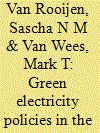

|
|
|
| 6 |
ID:
114302
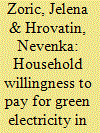

|
|
|
|
|
| Publication |
2012.
|
| Summary/Abstract |
This paper analyses the willingness to pay for electricity generated from renewable energy sources in Slovenia. The results confirm that age, household income, education and environmental awareness play the most important role in explaining household attitudes to green electricity programmes. While the willingness to participate in green electricity programmes is influenced by education and environmental awareness, the willingness to pay for green electricity predominantly depends on household income. The results imply that green marketing should be accompanied by awareness-raising campaigns and should target younger, well-educated and high-income households. The expressed median willingness to pay is found to exceed the current level of mandatory charges for green electricity. Nevertheless, recent increases in final electricity prices might have already exhausted the capacity for additional voluntary contributions.
|
|
|
|
|
|
|
|
|
|
|
|
|
|
|
|
| 7 |
ID:
116968
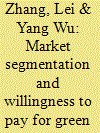

|
|
|
|
|
| Publication |
2012.
|
| Summary/Abstract |
The objective of this study is to identify market segments and estimate the residents' willingness to pay (WTP) for green electricity (green-e) in China for the large-scale promotion of energy projects from renewable sources that do not rely solely on energy policies. Based on an analysis of non-use values of green-e as well as the application of the contingent valuation (CV) method and payment card (PC) introduction technology, the average WTP ranges from RMB 7.91 yuan/month to 10.30 yuan/month (approximately US$ 1.15-1.51/month with an exchange rate of 6.83 yuan/US$ yuan/US$) for urban residents in Jiangsu Province. The current work also explores the differences in demographic variables across varying WTP amounts and the different marginal effects of demographic variables at the same level of WTP. The findings reveal that there are significant differences in demographic variables, such as level of education, household income and location of residence, across the population segments. Moreover, the finding that some respondents with high income and higher education prefer higher WTP amounts to lower WTP amounts suggests that green-e is a luxury product, and consequently, a Veblen effect exists in certain Chinese market segments.
|
|
|
|
|
|
|
|
|
|
|
|
|
|
|
|
| 8 |
ID:
127906
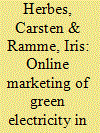

|
|
|
|
|
| Publication |
2014.
|
| Summary/Abstract |
There is an increasing body of research on consumer preferences concerning electricity from renewable resources. The purpose of this study is to analyze how providers' online marketing in one of the most developed markets for green energy can be improved. We conducted a content analysis of nearly 480 providers' websites, examining as many as 620 products. We found that energy providers' communication seems to be in line with academic research on potential customer benefits (utilitarian benefits, "warm glow", nature experience). However, communication could be improved by giving more detailed information on the impact of the consumer's decision, e.g. by giving numbers on CO2-emissions saved. Moreover, providers could improve the effectiveness of their visual messages by using more pictures related to renewable energy. Further, self-expressive benefits of buying green energy could be created by offering merchandise articles symbolizing the contribution a consumer makes by choosing a green tariff. When comparing purely green energy providers to other providers, we found that the former offer a wider choice as well as more products supporting new renewable installations. Important implications for policy makers aiming to phase out alternative energy subsidies emerge from our findings.
|
|
|
|
|
|
|
|
|
|
|
|
|
|
|
|
| 9 |
ID:
098653


|
|
|
|
|
| Publication |
2010.
|
| Summary/Abstract |
This paper provides a comprehensive overview of the main tax incentives used in the EU-27 member states (MSs) to promote green electricity. Sixteen MSs use tax incentives to promote green electricity simultaneously with other promotion measures, especially quota obligations and price regulation. However, not all available technologies are promoted. For example, six MSs (Germany, Romania, Slovak Republic, Denmark, Sweden and Poland) have included an exemption on the payments of excise duties for electricity when the electricity is generated from renewable energy sources (RES). This tax incentive is the most widely used. Limited tax incentives in personal income tax are available in Belgium, France, Czech Republic and Luxembourg. In corporate tax, tax incentives consist mainly of a deduction in the taxable profit (Belgium, Greece, Czech Republic and Spain). Lower tax rates in VAT are applied in three MSs, France, Italy and Portugal. Only Spain and Italy use effective tax incentives in property tax. As a great diversity of tax incentives has been used to promote green electricity, this adds another difficulty to the EU objective of providing a renewable energy policy framework, but also it offers a useful set of case studies which can be used to inform EU policy development.
|
|
|
|
|
|
|
|
|
|
|
|
|
|
|
|
| 10 |
ID:
092799
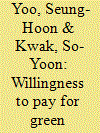

|
|
|
|
|
| Publication |
2009.
|
| Summary/Abstract |
Green electricity is energy that is generated from renewable energy sources such as solar power, wind power, small-scale hydroelectric power, tidal power, and biomass power. These sources mostly do not produce pollutants and are considered environmentally friendly. However, considering the current state of technology, they are more costly. Government should take visible actions to compensate for the increased production costs. This paper attempts to apply a contingent valuation (CV) method to obtain at least a preliminary evaluation of the benefits that ensue from the introduction of the policy that raises the percentage of green electricity consumption from 0.2% of the total electricity supply to 7% by 2011. Overall, the CV survey was successful in eliciting the willingness to pay (WTP) for green electricity considering that the CV method operated within respondents' abilities to answer and the WTP estimates were statistically significant. The monthly mean WTP estimates from parametric and non-parametric methods were KRW 1681 (USD 1.8) and KRW 2072 (USD 2.2), respectively. The estimates of the annual benefits to relevant residents amounted to KRW 150.5 billion (USD 157.5 million) and KRW 185.6 billion (USD 194.2 million), respectively.
|
|
|
|
|
|
|
|
|
|
|
|
|
|
|
|
|
|
|
|
|